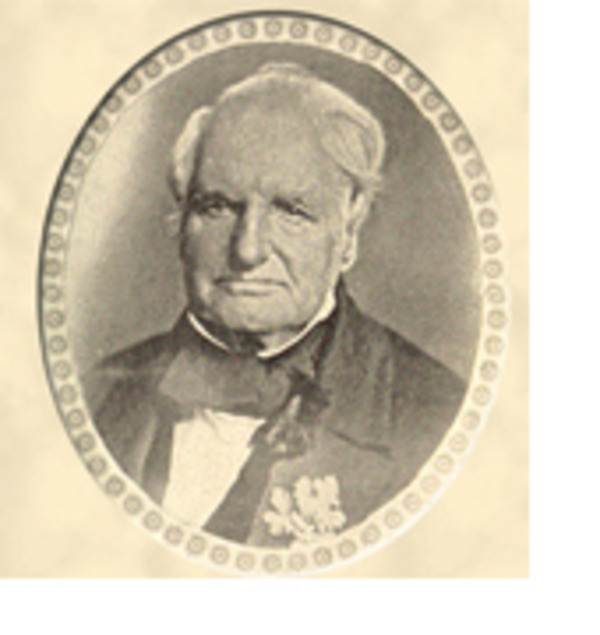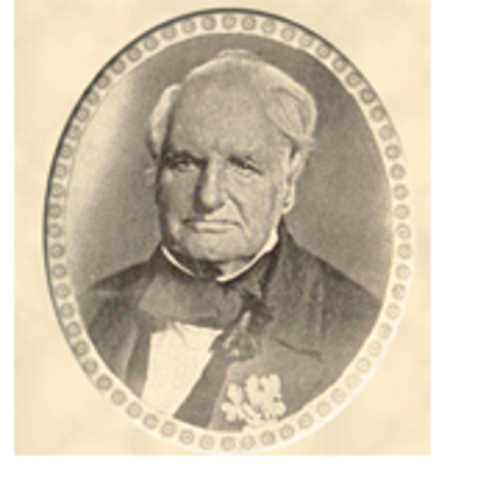
Source: Link
KEEFER (Kieffer), GEORGE, farmer, cabinetmaker, surveyor, militia officer, justice of the peace, and businessman; b. 8 Nov. 1773 near Newton, N.J., son of George Kieffer and Mary Cooke (Conke, Conck); m. first 6 Feb. 1797 Catherine Lampman, and they had nine children; m. secondly 8 June 1815 Jane Emory, née McBride, with whom he had seven children; m. thirdly 2 June 1836 Mary Swaize; m. fourthly 14 Nov. 1839 Esther Magdalen Secord; d. 27 June 1858 in Thorold, Upper Canada.
In about 1750 George Keefer’s father, then 10 years old, went to live near Paulins Kill, Sussex County, N.J., with his stepfather, Frederick Saveraine, and his mother, Ann Waldruff (widow of Samuel Kieffer, an Alsatian Huguenot). Within a few years the family operated two farms and a distillery, and was sufficiently well off to own a household slave. George Kieffer married Mary Cooke and they had four children (George, Jacob, Samuel, and Mary) before the American revolution tragically intervened. He joined the Queen’s Rangers to fight the rebels only to fall victim to army fever (probably typhus) in 1783. After the war Mary Kieffer remarried. She retained temporary possession of the family estate, but, on coming of age, her eldest son, George, faced the prospect of having it confiscated because of his father’s loyalism.
In 1790 Keefer, his brother Jacob, and several other lads from Sussex County in similar circumstances set out for Canada to look for land on which to make new beginnings. The Keefers located and began clearing a tract near present-day Thorold and in 1793 guided their family and a small herd of cattle overland to their rude farm. Once again the family began to prosper, assisted by a generous land grant; in 1797 George married Catherine Lampman, who had also made the trek from New Jersey, and children began to arrive at about the rate of one every 18 months. In addition to farming he worked as a cabinet-maker and about 1807 was appointed a deputy provincial land surveyor.
George Keefer remained ardently loyal during the War of 1812, joining the 2nd Regiment of Lincoln militia as an ensign at the outbreak of hostilities. In 1813 his house was commandeered as a hospital by American occupation forces and his wife died of army fever. His 16-year-old daughter, Elizabeth, assumed the trying burden of caring for the other children while she performed nursing chores for the invaders (one of whom later returned to marry her). Keefer rose to the rank of captain early in 1814; his company was active on the Niagara frontier throughout that summer, seeing action in July at the battle of Lundy’s Lane and in October at the engagement at Chippewa (Welland) River. He retained his captaincy in the 2nd Lincoln until 1828, when advancing age and declining interest led him to resign his commission.
After the war, Keefer opened a store, built a grist-mill on Twelve Mile Creek, and married Jane Emory, a widow with five children of her own. The future must have seemed promising for they had seven more children. In 1817 Keefer, who had become a justice of the peace three years earlier, and twelve of his neighbours replied with considerable satisfaction to the questionnaire of Robert Gourlay* on the state of settlement in Thorold Township. Its soil, they reported, could produce 15 to 30 bushels of excellent winter wheat per acre; crops of hay, oats, buckwheat, and barley were also good. The prospering township, their reply further revealed, had a population of 830 and contained a grist-mill, four sawmills, a linseed-oil mill, and several mercantile shops and taverns.
Keefer and John DeCow offered every encouragement when their friend and fellow mill-owner, William Hamilton Merritt*, proposed stabilizing the supply of water on Twelve Mile Creek by linking it to the Chippewa River, a project which developed into a plan to connect lakes Erie and Ontario by canal. Beginning in 1818 Keefer, DeCow, and Merritt conducted preliminary surveys, petitioned the provincial assembly for incorporation as a canal company, and organized local meetings to win public approval. Merritt needed men like Keefer, whose influence among landowners along the proposed route of the canal (which required 30 acres of Keefer’s own land) would help in the negotiation of the transfer of property rights. The Welland Canal Company was chartered in January 1824; Keefer subscribed for 25 shares and that summer, after Receiver General John Henry Dunn had refused the position, he was elected its first president. Merritt soon realized, however, that if he were to raise enough money in Canada and abroad to complete the canal, he would require someone with much greater prestige than Keefer at the head of the company. Dunn was again approached but did not immediately accept. Thus it fell to Keefer to let the first construction contracts and turn the first sod on 30 Nov. 1824. However, the growing scope of the scheme and its financial requirements quickly eclipsed such local notables as Keefer. Replaced by Dunn the following year, he drifted into the background, playing a minor financial role in support of Merritt and Dunn and attending board meetings regularly throughout the Niagara District but only infrequently at York (Toronto).
Keefer nevertheless made good use of the Welland Canal. Having obtained from the company free land opposite the site of what would become lock 34, he built a mill there in 1827 and waited for the canal to be completed – a bold declaration of faith and, for a time, a source of local amusement. Eventually the canal did arrive, providing upon its completion in 1829 essential water-power for the mill and a means of transportation.
Keefer was an enterprising, even-tempered, and widely respected patriarch who devoted himself to the formidable task of providing for a large, extended family. His last child was born when he was 52 and he was 60 when he lost his second wife in 1833. With several small children still at home, however, he remarried twice more. As he grew older he had the satisfaction of seeing his family well educated and firmly established in Canadian society as engineers, doctors, civil servants, and lawyers. The Welland Canal had captured the imagination of Keefer’s boys and its construction, repair, and rebuilding provided them with unusually advantageous opportunities for technical training and employment: three sons (George, Samuel*, and Thomas Coltrin*) learned or practised their trade there as civil engineers. Under the patronage of William Hamilton Merritt, who never forgot Keefer’s early support, they rose to places of distinction at the head of the emerging Canadian engineering profession. A fourth son, Jacob*, built one of the largest flour-mills in Canada on the banks of the canal at Thorold in 1845–47.
Like most of his contemporaries, George Keefer suffered greatly from events beyond his control. War made him a refugee and a soldier; it destroyed his patrimony and carried off his father, his first wife, and one of his sons. But in peace he prospered and his family flourished. Moreover, Keefer and his neighbours on Twelve Mile Creek possessed the vision and determination, if not the means, to improve their world with an ambitious scheme, the Welland Canal.
AO, MS 74; MS 191. PAC, MG 24, E1; I33; K2, 15: 291–93 (transcripts); National Map Coll., H 12/410-Welland Canal-1818; RG 9, I, B1, 3, 14; B7, 22, 25; RG 68, General index, 1651–1841: 24. Arthur papers (Sanderson), 3: 32, 325. “Grants of crown lands in U.C.,” AO Report, 1929: 88. St. Catharines Journal (St Catharines, [Ont.]), 1 July 1858. Chadwick, Ontarian families, 2: 90–98. Cyclopædia of Canadian biog. (Rose and Charlesworth), 1: 226–28. Morgan, Sketches of celebrated Canadians, 648–50. H. G. J. Aitken, The Welland Canal Company: a study in Canadian enterprise (Cambridge, Mass., 1954). The history of the county of Welland, Ontario . . . ([Welland], 1887; repr. with intro. by John Burtniak, Belleville, Ont., 1972), 361, 363, 531. M. W. Keefer, George Keefer (London, Ont., 1931). Robert Keefer, Memoirs of the Keefer family (Norwood, Ont., 1935). T. C. Keefer, The old Welland Canal and the man who made it (Ottawa, 1911), 9; Philosophy of railroads and other essays, ed. and intro. H. V. Nelles (Toronto, and Buffalo, N.Y., 1972), editor’s intro., vii–lxiii.
Cite This Article
H. V. Nelles, “KEEFER (Kieffer), GEORGE,” in Dictionary of Canadian Biography, vol. 8, University of Toronto/Université Laval, 2003–, accessed December 20, 2025, https://www.biographi.ca/en/bio/keefer_george_8E.html.
The citation above shows the format for footnotes and endnotes according to the Chicago manual of style (16th edition). Information to be used in other citation formats:
| Permalink: | https://www.biographi.ca/en/bio/keefer_george_8E.html |
| Author of Article: | H. V. Nelles |
| Title of Article: | KEEFER (Kieffer), GEORGE |
| Publication Name: | Dictionary of Canadian Biography, vol. 8 |
| Publisher: | University of Toronto/Université Laval |
| Year of publication: | 1985 |
| Year of revision: | 1985 |
| Access Date: | December 20, 2025 |



